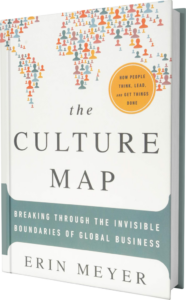Crafting Communication is a Strategic Choice
Dear readers,
One thing I love about our coaches, facilitators, and consultants is the variety of backgrounds, life experiences, and perspectives they bring and share with their clients and with our team.
Today, I’d like to introduce you to Julie Guirado, a wonderful leadership coach who often focuses on cross-cultural challenges. I asked her to share something with you on cross-cultural communication since so many of our clients now span multiple continents. I’m fascinated by Julie’s perspective on communicating and persuading across cultures and I’m now working through the book, The Culture Map, to learn more!
If you work in a cross-cultural environment (and really, who doesn’t these days?), reach out. I’d love to hear how this landed with you!
-Jessica
What matters most to you when you’re aiming to tell a compelling story? Is it the conclusion or the journey that led you there? Do you lead with your main point or build up to it? And do you adjust your storytelling based on your context, whether at home or at work?
Would you narrate it differently if you were with Kenyans, Koreans, Argentines, Austrians or Americans from the Mid-West? After working in over 30 countries, living in three and operating in three different languages, I’ve come to realize that there’s one aspect we don’t discuss enough: how we present information to others.

Based on my writing so far, where do you believe I stand?
As someone who grew up in France – I technically embody “principles-first”. I am comfortable sharing all my arguments and then landing on the main point at the end like the cherry on top! But I’ve learned that doesn’t fly in the US. I hope I am faring better than a typical French essay; ten pages split between arguments in favor, arguments against, and a conclusion blending both sides in the last paragraph.
After working with Americans for 15+ years and making a home in NYC, I’ve learned to embrace the “applications first” or main point first approach. It simply yields better results. A few months into my American work life, I was presenting the results of an experiment and guiding the audience through each analysis phase up to my conclusion: “This experiment resulted in an increase in X and a decrease in Y.” But, to my surprise, by the time I reached the final slide with my conclusion, half of the audience was on their phones, and the others trying to hide their annoyance at me for having wasted their time. Most importantly, no one grasped my main point! Because of the way I presented my message – not the actual results of the experiment – I didn’t convince the group of anything. What would have been successful in France somehow did not work in this new environment, I needed to adjust my delivery if I wanted anyone to listen to me.
So, what’s in it for you if, like most of us, you work with people from your own culture with a couple of one-offs here and there? The truth is culture is more than the color of our passport. It’s how we grew up, what we studied (think engineering vs. art design), who we listen to and how we connect to the world around us.
Let’s turn the lens on you:
- How do you like to receive information?
- Do you present information in the way you like to receive it?
- How do your various audiences react to the way you present?
- What’s the culture where you work? Applications first (main point first) or principles first (arguments first)?
- Does that fit your style?
The way we present information matters.
Understanding and adapting to the communication styles of different cultures (whether it’s your colleagues of the same nationality, or your colleagues from across an ocean) can bridge divides, foster collaboration, and drive success in our increasingly interconnected world.
As leaders, we have the responsibility to craft narratives that resonate across diverse audiences, spark enthusiasm, and drive meaningful change. In the end, it’s not just about what we say, but how we say it that truly matters.
Julie Guirado
Executive and Leadership Coach
ICF Associate Certified Coach


